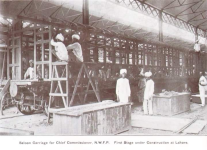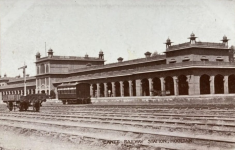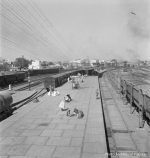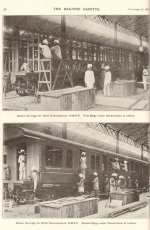Navigation
Install the app
How to install the app on iOS
Follow along with the video below to see how to install our site as a web app on your home screen.
Note: This feature may not be available in some browsers.
More options
Style variation
You are using an out of date browser. It may not display this or other websites correctly.
You should upgrade or use an alternative browser.
You should upgrade or use an alternative browser.
History of Pakistan Railways
- Thread starter ghazi52
- Start date
ghazi52
THINK TANK: CONSULTANT
- Mar 21, 2007
- 117,059
- 167,230
- Country of Origin

- Country of Residence

- Thread starter
- #18
Pai khel railway station
This station was built in 1890 AD.
The building of this station is very different from the usual stations - it looks like a fortress - at the corner of the building there are signs of a tower (minar) and the front of the fort.
The reason for the construction of the railway station in this way was that at one time armed tribal groups used to come from Waziristan and attack - the area from Daudkhel to Mianwali was under their control - in those times common people did not have weapons, so they attacked. The work of hours was very easy-
These armed groups were the real enemies of the British government- British had also set up military bases in Mari and Indus to eliminate them-
Pai Khel railway station was built in the same era - A police outpost and front were built here to protect the trains arriving and fro station installations.
Pai Khel station is about one kilometer away from the city - this is the joint railway station of Pai Khel and Moch.
Pai Khel Railway Station is very unique due to its historical importance and construction style.
Both gates at the station are made of thick and heavier iron sheets that used to be lowered with Chains help, which is now probably impossible due to rust. Everything about the station tells a story.
Now this station has become a victim of recession. If attention is not given, the mark of this historical heritage will also be erased soon.


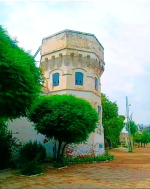
This station was built in 1890 AD.
The building of this station is very different from the usual stations - it looks like a fortress - at the corner of the building there are signs of a tower (minar) and the front of the fort.
The reason for the construction of the railway station in this way was that at one time armed tribal groups used to come from Waziristan and attack - the area from Daudkhel to Mianwali was under their control - in those times common people did not have weapons, so they attacked. The work of hours was very easy-
These armed groups were the real enemies of the British government- British had also set up military bases in Mari and Indus to eliminate them-
Pai Khel railway station was built in the same era - A police outpost and front were built here to protect the trains arriving and fro station installations.
Pai Khel station is about one kilometer away from the city - this is the joint railway station of Pai Khel and Moch.
Pai Khel Railway Station is very unique due to its historical importance and construction style.
Both gates at the station are made of thick and heavier iron sheets that used to be lowered with Chains help, which is now probably impossible due to rust. Everything about the station tells a story.
Now this station has become a victim of recession. If attention is not given, the mark of this historical heritage will also be erased soon.



ghazi52
THINK TANK: CONSULTANT
- Mar 21, 2007
- 117,059
- 167,230
- Country of Origin

- Country of Residence

- Thread starter
- #21
Pakistan Railways - North Western Railway of Pakistan (Khyber Pass) - 2-8-0 steam locomotive and freight train coming out of a tunnel on the Khyber Railway (vintage postcard)

The Khyber Pass is a mountain pass that links Pakistan and Afghanistan. Throughout history it has been an important trade route between Central and Southern Asia and a strategic military location.
This postcard is dated to the conclusion of the third Anglo-Afghan war of 1919, showing a train emerging from a tunnel on the Khyber Pass Railway.
By 1978, there was just one weekly train, a Fridays Only (FO) service that in theory ran to take people to the weekly market at Landi Kotal (8km from the border with Afghanistan). The train only ran with two or three coaches, and demand for the service was not great.
The FO service ceased sometime in the 1990s. There were at least a couple of attempts at running a regular tourist service, but the deteriorating security situation in the region, plus Pakistan losing its attraction as a tourist destination saw the last charter trips run towards the end of 2005.
Some of the Class HGS 2-8-0 locomotives may be tucked away in a shed at Peshawar, waiting to be reactivated should the opportunity ever arise.

The Khyber Pass is a mountain pass that links Pakistan and Afghanistan. Throughout history it has been an important trade route between Central and Southern Asia and a strategic military location.
This postcard is dated to the conclusion of the third Anglo-Afghan war of 1919, showing a train emerging from a tunnel on the Khyber Pass Railway.
By 1978, there was just one weekly train, a Fridays Only (FO) service that in theory ran to take people to the weekly market at Landi Kotal (8km from the border with Afghanistan). The train only ran with two or three coaches, and demand for the service was not great.
The FO service ceased sometime in the 1990s. There were at least a couple of attempts at running a regular tourist service, but the deteriorating security situation in the region, plus Pakistan losing its attraction as a tourist destination saw the last charter trips run towards the end of 2005.
Some of the Class HGS 2-8-0 locomotives may be tucked away in a shed at Peshawar, waiting to be reactivated should the opportunity ever arise.
ghazi52
THINK TANK: CONSULTANT
- Mar 21, 2007
- 117,059
- 167,230
- Country of Origin

- Country of Residence

- Thread starter
- #22
The first train to Jammu from Sialkot, 1890.

The Jammu–Sialkot line was a 43 km (27 mi) broad gauge branch of the North Western State Railway from Wazirabad Junction, Punjab, to Jammu, passing through the Sialkot Junction.
The section from Sialkot to Jammu (Tawi) was 27 miles (43 km) long, partly in the British Indian province of Punjab and partly in the princely state of Jammu and Kashmir Built in 1890 during the reign of Maharaja Pratap Singh, it was the first railway line in the state of Jammu and Kashmir connecting Jammu-Amritsar via Lahore.
The railway line ran till 18 September 1947, when the newly made Pakistan, which inherited the North Western State Railway from united India, suspended the train service.The railway line fell into disrepair.A new line between Pathankot and Jammu was built by Indian Railways in 1972.
The government of Maharaja Hari Singh made a standstill agreement with Pakistan for continuance of all the pre-existing arrangements.
However, the railway service was suspended by Pakistan on or about 18 September 1947.The act was regarded as a violation of the standstill agreement by Jammu and Kashmir. It also created hardships for the Jammu Muslims who wanted to find safety in Sialkot in the midst of increasing communal tension in Jammu.
With the state's accession to India on 26 October and the ensuring Kashmir war between the two Dominions, the suspension of the railway line became permanent. The train service was never resumed.

The Jammu–Sialkot line was a 43 km (27 mi) broad gauge branch of the North Western State Railway from Wazirabad Junction, Punjab, to Jammu, passing through the Sialkot Junction.
The section from Sialkot to Jammu (Tawi) was 27 miles (43 km) long, partly in the British Indian province of Punjab and partly in the princely state of Jammu and Kashmir Built in 1890 during the reign of Maharaja Pratap Singh, it was the first railway line in the state of Jammu and Kashmir connecting Jammu-Amritsar via Lahore.
The railway line ran till 18 September 1947, when the newly made Pakistan, which inherited the North Western State Railway from united India, suspended the train service.The railway line fell into disrepair.A new line between Pathankot and Jammu was built by Indian Railways in 1972.
The government of Maharaja Hari Singh made a standstill agreement with Pakistan for continuance of all the pre-existing arrangements.
However, the railway service was suspended by Pakistan on or about 18 September 1947.The act was regarded as a violation of the standstill agreement by Jammu and Kashmir. It also created hardships for the Jammu Muslims who wanted to find safety in Sialkot in the midst of increasing communal tension in Jammu.
With the state's accession to India on 26 October and the ensuring Kashmir war between the two Dominions, the suspension of the railway line became permanent. The train service was never resumed.
ghazi52
THINK TANK: CONSULTANT
- Mar 21, 2007
- 117,059
- 167,230
- Country of Origin

- Country of Residence

- Thread starter
- #24
A view of a street near the Faisalabad station where a train route used to be
. . .

Railway team undertaking Construction of Railway Bridge over River Indus at Kalabagh,
circa 1929-31

. . .

Railway team undertaking Construction of Railway Bridge over River Indus at Kalabagh,
circa 1929-31

ghazi52
THINK TANK: CONSULTANT
- Mar 21, 2007
- 117,059
- 167,230
- Country of Origin

- Country of Residence

- Thread starter
- #26
The driver who took pride in his job. All decorations are his personal effects
How I can forget this passionate driver of Lahore Loco shed He has purchased Small National Flags And Many garlands for decorations.
when he took the charge of the Engine first of all he Tied National flags on both sides of his loco and Driver Cabin with garlands this Job that was also Electric Locomotive with 23 Up Quetta Express in 1987.
His Name was Haider Ali Very Famous By the Name of BABA HAIDER JHANDAY WALI SARKAR If You Zoom the Picture you can see those Flags and decorations inside the loco cab

How I can forget this passionate driver of Lahore Loco shed He has purchased Small National Flags And Many garlands for decorations.
when he took the charge of the Engine first of all he Tied National flags on both sides of his loco and Driver Cabin with garlands this Job that was also Electric Locomotive with 23 Up Quetta Express in 1987.
His Name was Haider Ali Very Famous By the Name of BABA HAIDER JHANDAY WALI SARKAR If You Zoom the Picture you can see those Flags and decorations inside the loco cab

hussain
Full Member
- Nov 24, 2022
- 501
- 495
- Country of Origin

- Country of Residence

Our trains run at a measly pace, 24 to 26 hrs on Green-line from Islamabad to Karachi. I'm hoping ML-1 will get upgraded in my lifetime, and it'll be able to make it in 10 hrs or less! @ghazi52 @RescueRanger I'll book a cabin for PDF'ers 
Users who are viewing this thread
Total: 1 (members: 0, guests: 1)
Pakistan Defence Latest
-
-
-
-
Azerbaijan Air Force Becomes Fourth Operator of JF-17 Fighter Aircraft, President Aliyev Confirms (1 Viewer)
- Latest: FOOLS_NIGHTMARE
-
Country Watch Latest
Latest Posts
-
Hezbollah-Israel Conflict 2024 - Lebanon & Occupied Palestine Territories (52 Viewers)
- Latest: Falcon29
-
-
-
-

